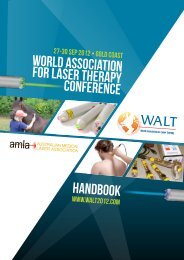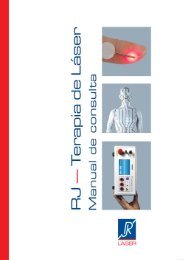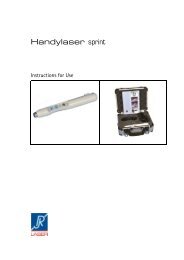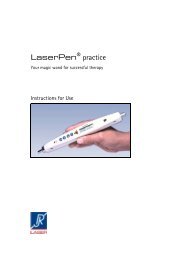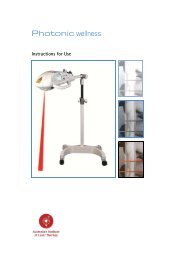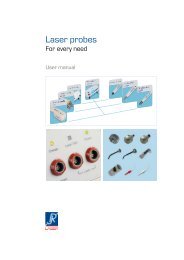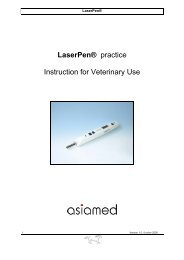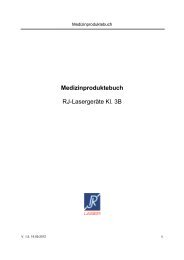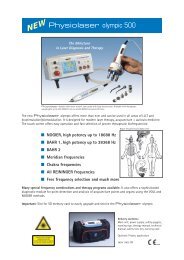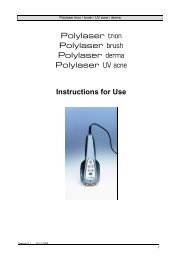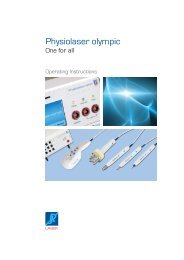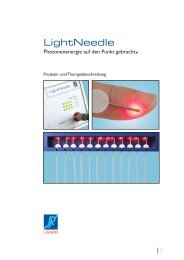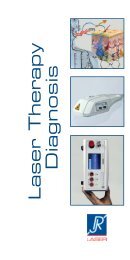LightNeedle - RJ Laser
LightNeedle - RJ Laser
LightNeedle - RJ Laser
You also want an ePaper? Increase the reach of your titles
YUMPU automatically turns print PDFs into web optimized ePapers that Google loves.
Original Article<br />
G. Litscher<br />
European Journal of Anaesthesiology 2004; 21: 13-19<br />
@ 2004 European Academy of Anaesrhesiology<br />
ISSN 0265-0215<br />
University of Graz, Department of Biomedical Engineering and Research in Anesthesia and Intensive Care, Graz, Austria<br />
Summary<br />
Background and objective: The main purpose of this study was to investigate the effects of sensory (acupressure<br />
and acupuncture) and optical stimulation (<strong>Laser</strong>needle@ acupuncture) on electroencephalographic bispectral<br />
index, spectral edge frequency and a verbal sedation score.<br />
Methods: Twenty-five healthy volunteers (mean age :!: SD: 25.5 :!: 4.0yr) were investigated during the<br />
awake state. The acupuncture point Yintang and a placebo control point were stimulated. The study was per-<br />
formed as a randomized, controlled and partly blinded cross-over trial.<br />
Results: Bispectral index and spectral edge frequency values both decreased significantly (P < 0.001) during acu-<br />
pressureonYintang tovalues of62.9 (minimum 35) :!: 13.9 bispectral indexand to 13.3 (minimum 2.9) :!: 8.1 Hz<br />
(spectral edge frequency right) and 13.8 (minimum 2.7) :!: 7.3 Hz (spectral edge frequency left), respectively.<br />
Bispectral index was also significantly (P < 0.05) affected by <strong>Laser</strong>needle@ acupuncture and acupressure on the<br />
control point but the changes were not clinically relevant, 95.4 :!: 4 and 94.2 :!: 4.8, respectively. All interventions<br />
significantly (Yintang: p < 0.001; control point: p < 0.012) reduced verbal sedation score.<br />
Conclusions: The study highlights the electroencephalographic similarities of acupressure induced sedation<br />
and general anaesthesia as assessed by bispectral index and spectral edge frequency.<br />
Keywords: ACUPRESSURE; ACUPUNCTURE; ELECTROENCEPHALOGRAPHY, bispectral index, spectral edge<br />
frequency.<br />
Noninvasive bioelectrical neuromonitoring is gaining<br />
more and more attention in anaesthesia and<br />
critical care [1,2]. The bispectral index (BIS) and the<br />
spectral edge frequency (SEF) are important numerical<br />
descriptors of the electroencephalogram (EEG)<br />
and both are mainly used for assessing depth of<br />
anaesthesia [3]. If anaesthetists relyon BIS and SEF<br />
to detect awareness, then it is very important to<br />
Correspondence ro. Gerhard Lirscher, Departmenr of Biomedical Engineering<br />
and Research in Anesthesia and Intensive Care, University of Graz,<br />
Auenbruggerplatz 29, A-8036 Graz, Austria. E-mail: gerhard.litscher@<br />
uni-grazat; Tel. +433163853907/83907; Fax. +433163853908<br />
Accepted for publication August 2003 EJA 1537<br />
exclude other influences that could give false readings.<br />
It is known that a number of environmental<br />
and physiological factors may affect BIS performance.<br />
Recently it has been reported that nonpharmacological<br />
interventions such as acupressure can also<br />
reduce BIS values significantly [4].<br />
This study is a randomized, controlled and partly<br />
blinded (<strong>Laser</strong>needle@ acupuncture; LASCO Int.<br />
Medical Mark. AG, Basel, Switzerland) cross-over<br />
trial intended to investigate the effects of three nonpharmacological<br />
interventions (acupressure, manual<br />
needle acupuncture and <strong>Laser</strong>needle@ acupuncture)<br />
on two processed EEG variables (BIS and SEF) and a<br />
verbal sedation score (VSS) in healthy volunteers.



